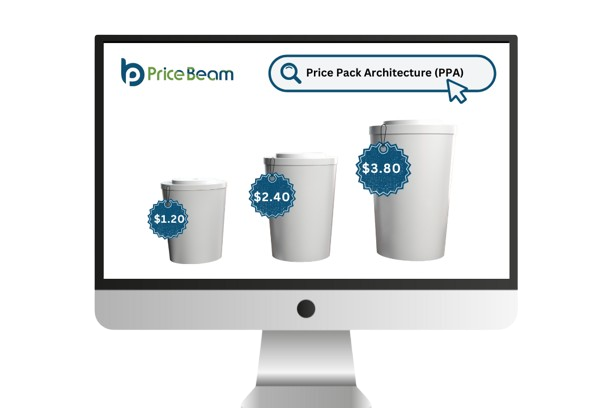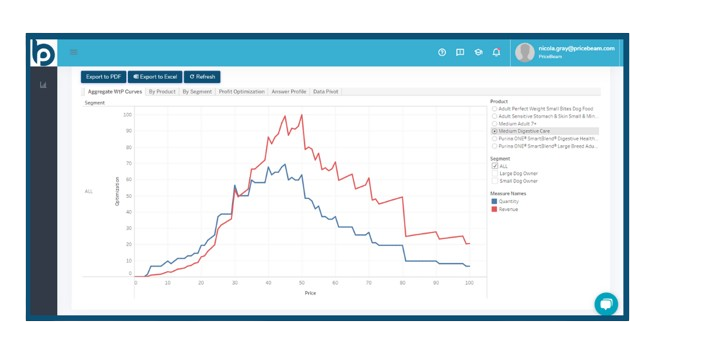Revenue Growth & Price Optimization in 2025 - Hots and Nots
 PriceBeam
·
10 minute read
PriceBeam
·
10 minute read
With inflation having slowed down in many markets, teams responsible for price setting in 2025 and beyond need to look to new approaches, beyond simply increasing top-line prices. Especially, as shareholders and senior management are seeking growth in volume, customers, and general topline growth.
Businesses that are experiencing swift and significant changes in pricing dynamics, evolving consumer expectations, and advancements in technological capabilities must harness the power of data-driven insights to remain competitive. It is crucial for these businesses to apply analytics to understand market trends, consumer behavior, and the factors that truly drive value in their offerings. By focusing on what genuinely adds value to their products and services, companies can better align their strategies with customer needs and market demands.
In the following sections, we provide a detailed exploration of the "Hots", the innovative strategies and practices that are shaping the revenue growth landscape of 2025. These are the approaches that are proving to be effective in driving growth and profitability in the current business environment. Conversely, we also highlight the "Nots", the methods and strategies that may no longer be effective or relevant in the 2025 RGM model. These are the approaches that businesses should reconsider or abandon to avoid falling behind in a rapidly changing market.
7 Hots
Topline growth through RGM insights
Most industries and businesses cannot rely on simply raising topline prices next year. While there are exceptions in industries where well-known input prices have exploded, such as cocoa for chocolate, in most cases consecutive years of higher-than-normal inflation and price increases have put a ceiling on what customers and consumers are willing to accept.
Similarly, just as simple across-the-board price increases are difficult to continue next year, so is "shrinking to glory", i.e. reducing pack size while keeping prices constant. A series of press exposures and trade de-listings of consumer goods manufacturers who have reduced sizes too much in the eye of the consumers and the retailers have made shrinkflation actions much more difficult to get away with.
Therefore, businesses must in 2025 explore new strategies to expand their consumer base, attract new customers, and enhance their distribution channels. This involves not only identifying untapped markets and demographics but also developing new products and services that cater to evolving consumer needs and preferences. By adopting a comprehensive approach to growth, businesses can ensure they are well-positioned to capture new opportunities and drive sustainable topline expansion in a competitive market landscape.
Revenue Growth Management (RGM) leverages analytics to understand consumer behavior, price elasticity, and channel performance. Companies are increasingly using RGM to drive topline growth by identifying profitable customer segments, optimizing pricing by market, and finding new growth areas.
Holistic pricing
Holistic pricing looks beyond individual product prices and considers the entire customer journey, bundling, and added services. This approach aligns with the shift toward customer-centric models, optimizing both customer satisfaction and revenue through integrated pricing strategies that add value.
Holistic pricing acknowledges that growth in revenue doesn't just come from individual price increases. It comes for optimizing prices across an entire assortment, by channel and customer segment, against the needs of the buyers and consumers in those segments and channels. It also keeps a keen eye on the competitive landscape albeit without following competitive moves one-to-one. A strong competitive price strategy considers gaps in willingness-to-pay versus the competition and is capable of simulating moves that are either unilateral or in sync with the competitors' moves.
Similarly, holistic pricing also takes into consideration discounts and promotions and thus looks at optimizing the whole revenue across all products and after all relevant market investments.
Innovation Pricing
Innovation pricing is a strategic approach that involves setting prices on new products or services, often incorporating a premium that reflects the unique features or technological advancements these offerings bring to the market. This pricing strategy is particularly effective for businesses aiming to capture additional value from early adopters—those consumers who are eager to experience the latest innovations and are willing to pay a higher price for the privilege. But also in generally available products and brands, there are often consumers willing to pay a higher price, either because they simply can or want to, or because they appreciate certain benefits and features more than the next customer.
Furthermore, innovation pricing aids in differentiating a brand in a crowded marketplace, allowing businesses to stand out by highlighting the distinct advantages and benefits their new products or services offer. This differentiation is crucial in establishing a competitive edge and ensuring long-term success in an ever-evolving business environment.
PPA 2.0, not just Shrinkflation
Instead of simply reducing product sizes, a tactic commonly known as shrinkflation, PPA 2.0 represents a more sophisticated and strategic approach to packaging and pricing. This strategy involves making deliberate and informed decisions about offering a variety of package sizes, formats, and price points to better meet consumer needs and preferences. As consumers become increasingly aware and critical of shrinkflation practices, businesses must pivot towards providing clear, distinct, and varied packaging options that not only enhance customer satisfaction but also foster brand loyalty. By doing so, companies can support a pricing strategy that is both transparent and adaptable, allowing them to maintain consumer trust while effectively responding to market demands and competitive pressures. This approach not only helps in retaining existing customers but also attracts new ones by demonstrating a commitment to value and choice, ultimately driving long-term growth and profitability.


PPA 2.0 involves looking at willingness-to-pay across not only pack sizes but also integrating insights about needs and desires, usage occasions, channels, and brand preferences into a single RGM optimization picture. What consumers are willing to pay for a brand indeed varies between the channels they buy (e.g. supermarket vs convenience), the occasion (weekly family shop vs convenience to have a Friday evening snack), or the occasion (consuming myself versus taking to friends' house to show I have good taste). PPA 2.0 is about measuring willingness-to-pay across all these dimensions and then optimizing the product offering accordingly. This doesn't preclude smaller pack sizes in some instances, but it doesn't simply rely on pack sizes.
RGM as a Discipline
Treating Revenue Growth Management (RGM) as a formalized discipline involves establishing dedicated teams, processes, and frameworks that are specifically focused on maximizing revenue across all aspects of the business. This means creating specialized roles and departments that are solely responsible for analyzing market data, consumer behavior, and pricing strategies to ensure that every decision is informed by comprehensive insights. By implementing a structured approach, companies can make data-driven decisions that are not only precise but also adaptable to changing market conditions. This involves rigorous assessment of pricing impacts, allowing businesses to evaluate the effectiveness of their strategies and make necessary adjustments to optimize outcomes.
Furthermore, by embedding RGM as a core organizational function, companies can sustain revenue growth over a longer term, ensuring that it becomes an integral part of their business model and culture. This strategic focus on RGM enables businesses to remain competitive, agile, and responsive to both internal and external challenges, ultimately driving sustained profitability and success.
Data-Founded Price Increases
Price increases should be meticulously grounded in comprehensive data analysis, utilizing forward-looking market research to capture the latest trends and shifts in consumer behavior. This approach also takes into account cost increases, ensuring that any adjustments in pricing are reflective of the actual market landscape. Additionally, a deep understanding of consumer willingness-to-pay is integrated into the pricing strategy, allowing companies to set prices that align with what customers are prepared to spend. By making informed price adjustments, businesses can protect their brand perception, ensuring that customers continue to see value in their offerings.
This careful balance also helps maintain profitability and competitive positioning, which is especially crucial during periods of inflation or when supply chain disruptions occur. During such challenging times, data-driven pricing strategies enable companies to navigate economic fluctuations effectively, safeguarding their market presence and ensuring long-term success.
TDPO: Test-Driven Price Optimization
Test-Driven Price Optimization (TDPO) is a strategic approach that involves conducting a series of carefully designed pricing experiments to collect detailed data on how customers react to different pricing scenarios.
By implementing these experiments in a controlled environment, businesses can observe and analyze customer behavior and preferences without the risk of making premature or uninformed pricing changes across their entire product line. This method significantly reduces the potential for negative impacts on sales and customer satisfaction by ensuring that any adjustments to pricing strategies are thoroughly validated and supported by empirical evidence.
Historically, such experiments were difficult to implement and rather costly, as they were done on live shelves. However, with modern testing and research technologies used by e.g. PriceBeam, companies can test different prices in virtual environments, gather what consumers prefer, and then use these insights together with AI to build virtual consumer models that can be queried on an ongoing basis. Test once, and simulate many.
The insights gained from these experiments are invaluable, as they provide a comprehensive understanding of how different customer segments perceive value and respond to price variations. This enables companies to tailor their pricing strategies more precisely, optimizing them to meet the specific needs and expectations of diverse customer groups. Ultimately, TDPO empowers businesses to make informed, data-driven decisions that enhance profitability while maintaining strong customer relationships and market competitiveness.
7 Nots
Simple Price Increases Across the Portfolio
Implementing basic across-the-board price hikes can significantly erode customer trust and may fail to accurately reflect the true value of the products or services being offered. In today's market, consumers are more informed and discerning than ever before, and they expect pricing that is fair and justified in the value offered.
They look for price increases that are justified by added value, such as enhanced features, improved quality, or additional services, or that are accompanied by clear and transparent reasons, such as increased production costs or market changes. Without these justifications, customers may feel that they are being unfairly charged, leading to dissatisfaction and a potential loss of loyalty. Therefore, businesses must carefully consider their pricing strategies to ensure they align with consumer expectations and maintain trust.
Where price increases still are justified businesses must work the public perception continuously, to establish that sense of fairness: "OK, I heard that cocoa prices have tripled and therefore I guess it is OK that my favorite chocolate brand's price has gone up". If I hadn't heard about it, it just become yet another "greedy" chocolate manufacturer increasing prices.
Price increases in 2025 will still take place, as they should (from a manufacturer's perspective). After all, we don't have negative inflation. But they must be differentiated by product, category, channel, segment, and other dimensions and aligned with market willingness-to-pay. Not a simple across-the-board price increase for all products in the portfolio.
Over-Reliance on Promotions
Relying heavily on constant promotions can significantly undermine a brand's perception in the eyes of consumers. When discounts and special offers become the norm rather than the exception, customers may begin to associate the brand with lower value, questioning the true worth of its products or services. This habitual discounting can lead to increased price sensitivity among consumers, who may start to expect reduced prices as a standard, making them less inclined to pay the full price for products.
As a result, the perceived value of the brand diminishes, and customers may become more focused on price rather than the quality or unique attributes of the offerings. This shift in consumer behavior can erode long-term profitability, as businesses find themselves trapped in a cycle of needing to offer continuous promotions to maintain sales volumes. Over time, this strategy can also strain profit margins, as the constant need to discount eats into potential revenue. Moreover, it can hinder a brand's ability to build strong, loyal customer relationships, as consumers may become more transient, moving from one promotion to the next without developing a lasting connection to the brand. To avoid these pitfalls, businesses should aim to balance promotional activities with strategies that emphasize the intrinsic value and benefits of their products, fostering a more sustainable and profitable customer base.
Shrinkflation
Shrinkflation, the practice of reducing product size while keeping the price unchanged, is increasingly falling out of favor as consumers become more vigilant and informed about such tactics. This growing awareness among consumers is leading to heightened scrutiny and criticism, as they feel deceived when they receive fewer products for the same amount of money. As a result, shrinkflation can significantly damage brand loyalty, as customers may perceive it as a lack of transparency and honesty from the company. This perception can erode trust and diminish the perceived value of the brand's offerings, prompting consumers to seek alternatives that they believe offer better value for their money. In a market where consumer trust and brand reputation are paramount, businesses must reconsider the use of shrinkflation and explore more transparent and value-driven strategies to maintain and enhance customer relationships.
Competitor-Based Pricing
Relying exclusively on competitor-based pricing strategies can initiate destructive price wars, where businesses continuously undercut each other to maintain market share, ultimately eroding profit margins and destabilizing the industry. This approach often fails to recognize and capitalize on the unique attributes and value propositions that a company’s products or services may offer, leading to a homogenization of offerings that diminishes brand differentiation and customer loyalty. Instead, adopting a more robust pricing strategy that emphasizes value-based and data-driven methodologies is far more sustainable in the long run.
By focusing on the intrinsic value that products or services provide to consumers, companies can set prices that reflect the true worth of their offerings, thereby enhancing customer satisfaction and loyalty.
Additionally, leveraging data-driven insights allows businesses to make informed pricing decisions based on comprehensive market analysis, consumer behavior, and willingness-to-pay metrics, ensuring that pricing strategies are not only competitive but also aligned with the company’s overall business objectives and market positioning. This strategic shift not only safeguards profitability but also fosters innovation and growth by encouraging companies to continuously enhance their value propositions to meet evolving consumer needs and preferences.
Line pricing
Applying the same price across similar products, a strategy known as line pricing, can significantly restrict a company's profitability and fail to accurately reflect the varying value or demand for individual items within a product line. This approach often overlooks the unique attributes and benefits that different products may offer, which can lead to missed opportunities for maximizing revenue. For instance, some products may have features or qualities that justify a higher price point, while others may appeal to a more cost-conscious segment of the market. By not differentiating prices based on these factors, businesses risk undervaluing certain products and overpricing others, which can result in decreased sales and customer dissatisfaction. Furthermore, line pricing does not account for fluctuations in consumer demand, which can vary widely depending on factors such as seasonality, market trends, and consumer preferences. By adopting a more nuanced pricing strategy that considers these variables, companies can better align their pricing with the true market value of each product, ultimately enhancing profitability and customer satisfaction.
Universal Global prices
A one-size-fits-all pricing approach across all countries around the globe fails to take into account the unique characteristics and economic conditions of different regions, such as local market dynamics, cultural preferences, and variations in purchasing power. This oversight can lead to pricing strategies that are not aligned with the specific needs and capabilities of consumers in diverse markets. As a result, businesses may inadvertently alienate certain customer segments, diminishing their brand's appeal and relevance in those areas. Moreover, by not tailoring prices to reflect local economic realities, companies risk losing their competitive edge, as they may be perceived as out of touch or unresponsive to the distinct demands of each market. This can ultimately hinder a company's ability to effectively penetrate and succeed in global markets, where adaptability and sensitivity to local conditions are crucial for sustained growth and profitability.
Tea Leaves Insights aka Synthetic Market Research
Relying on assumptions or “gut feeling” market research can be highly inaccurate and potentially detrimental to a business's strategic planning and decision-making processes. In today's complex and rapidly evolving market landscape, where consumer preferences and market dynamics are constantly shifting, businesses cannot afford to base their strategies on intuition alone.
One troubling trend in market research at the moment is the advent of "synthetic" customers where one asks GPT-style models for what they "think" about a certain product or service. Prompts similar to "imagine you are a 43-year-old woman, married, living in Los Angeles, two kids and a husband, you both work. What would you be willing to pay for Product X?" The problem is that GPT models more often than not will try to answer that question, but its answer is based on its training set which invariably uses non-category, non-product specific data, and its output is pure guesswork. The allure is that it looks like the GPT seems confident in its answers but the response is not more precise than reading tea leaves.
Instead, businesses must leverage precise, data-driven insights that are grounded in comprehensive market analysis and empirical evidence. This approach enables companies to make informed decisions that are not only accurate but also aligned with current market trends and consumer behaviors. Indeed such data can then be fed into AI models, even chat-style query prompts, but it is the foundation in current, category-specific market research that makes the virtual customer in that case a much more precise and accurate predictor of choice and preference.
Learn More
Revenue growth and pricing strategies are evolving rapidly in 2025, and staying on top of these trends will be essential for businesses aiming to remain competitive. Adopting a disciplined RGM approach, investing in data and testing, and focusing on consumer-centric pricing strategies can make all the difference in navigating this new landscape.
Follow PriceBeam on our social media channels, or get in touch with our team to see how we can help you do better pricing in 2025.
.png?width=400&height=100&name=PBLogoTransparent%20(1).png)




.jpg)